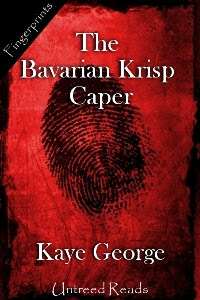John Kenyon is the editor of griftmagazine.com and the forthcoming print debut of Grift. He has stories in the first two issues of Pulp Modern, and upcoming in Needle, Beat to a Pulp and All Due Respect.
Here's his post:
 |
| painting by Elisabeth Jerichau Baumann |
If one reads the original Grimm Brothers tales, they are quite dark. Over the years, however, the audience for these tales has shifted. No longer are they frightening cautionary tales aimed at adults. No, they now are aimed squarely at children, sanitized lest their little minds conjure too terrifying a scenario before bed.
It was while reading one of these toned-down versions that I began thinking of a story that was decidedly adult in its composition. In the version I read, there is only the hint of menace; everything always works out in the end. This book, Mary Engelbreit's Nursery Tales, bolsters each story with fanciful drawings that depict everyone involved as some sort of post-Precious Moments cherub, all rosy cheeks and broad smiles.
"The landscapes glimpsed in her meticulously rendered pictures more closely resemble a park or playground than a wild wood," writes children's literature historian Leonard S. Marcus in his introduction. "Really scary things couldn't possibly happen here."
That's all well and good for children -- I've rushed into my three-year-old's room to quiet the swirl of images brought about by a nighttime tale that was a bit too vivid for his young imagination -- but, um, bleeds much of the power from these classic tales.
My idea was simple: recast these stories as modern-day crime fiction tales. It wouldn't take much. In each there is a protagonist who, while not always entirely innocent, at least has the reader firmly in his or her camp, and an aggressor who is trying to take what isn't rightfully his. Add a few guns and some coarse language, and "The Three Little Bears" or "Little Red Riding Hood" aren't too far from the latest story revolving around a robbery or a heist.
I wrote a story, but feared it would get lost without the proper context. I held a contest, asking others to do likewise, and came up with the batch of stories that eventually became Grimm Tales.
My own story updated "Puss in Boots," recasting the mischievous cat as a thigh-high boot wearing stripper. Others dug deeper, going for more obscure stories that nonetheless translated well to the world of modern crime fiction.
"Let the big bad wolf huff and puff if he must," Marcus writes to conclude his introduction to the illustrated book I read to my kids. "Happy endings await."
Not here. The real world doesn't operate that way. As Ken Bruen writes in the introduction to our book, "Ever imagined what would have come down the dark pike if The Brothers Grimm were more Brothers Coen and wrote mystery?"
It was while reading one of these toned-down versions that I began thinking of a story that was decidedly adult in its composition. In the version I read, there is only the hint of menace; everything always works out in the end. This book, Mary Engelbreit's Nursery Tales, bolsters each story with fanciful drawings that depict everyone involved as some sort of post-Precious Moments cherub, all rosy cheeks and broad smiles.
"The landscapes glimpsed in her meticulously rendered pictures more closely resemble a park or playground than a wild wood," writes children's literature historian Leonard S. Marcus in his introduction. "Really scary things couldn't possibly happen here."
That's all well and good for children -- I've rushed into my three-year-old's room to quiet the swirl of images brought about by a nighttime tale that was a bit too vivid for his young imagination -- but, um, bleeds much of the power from these classic tales.
My idea was simple: recast these stories as modern-day crime fiction tales. It wouldn't take much. In each there is a protagonist who, while not always entirely innocent, at least has the reader firmly in his or her camp, and an aggressor who is trying to take what isn't rightfully his. Add a few guns and some coarse language, and "The Three Little Bears" or "Little Red Riding Hood" aren't too far from the latest story revolving around a robbery or a heist.
I wrote a story, but feared it would get lost without the proper context. I held a contest, asking others to do likewise, and came up with the batch of stories that eventually became Grimm Tales.
My own story updated "Puss in Boots," recasting the mischievous cat as a thigh-high boot wearing stripper. Others dug deeper, going for more obscure stories that nonetheless translated well to the world of modern crime fiction.
"Let the big bad wolf huff and puff if he must," Marcus writes to conclude his introduction to the illustrated book I read to my kids. "Happy endings await."
Not here. The real world doesn't operate that way. As Ken Bruen writes in the introduction to our book, "Ever imagined what would have come down the dark pike if The Brothers Grimm were more Brothers Coen and wrote mystery?"
PS. If you MUST read these tales, the links are just to the right.













